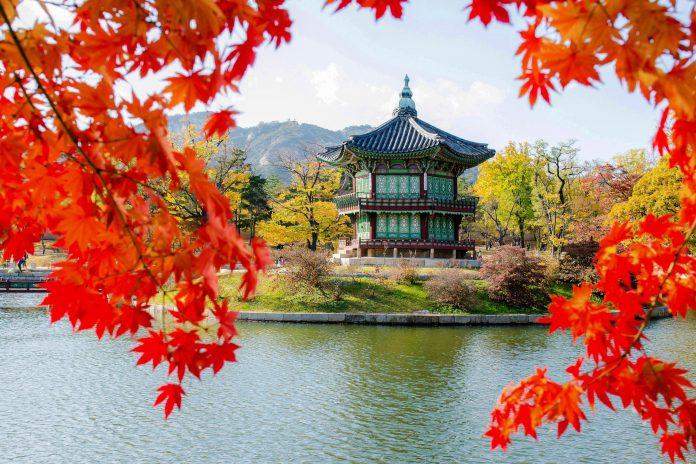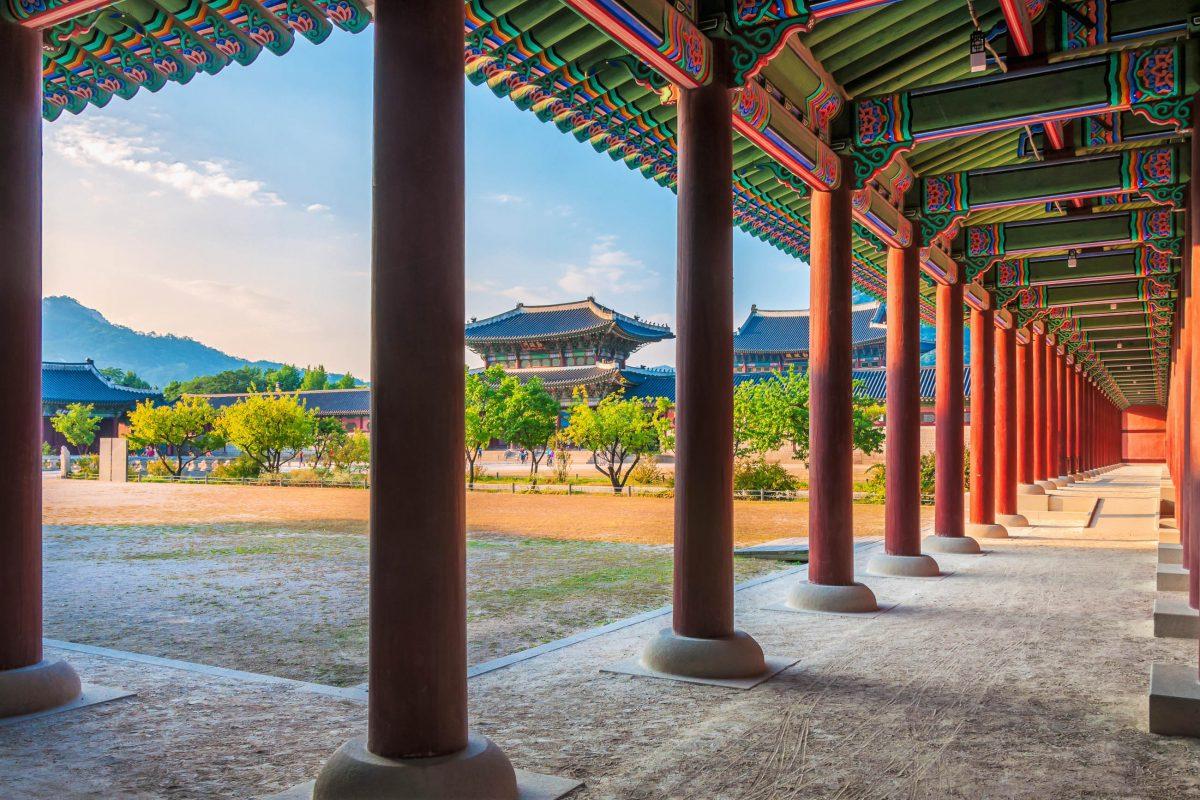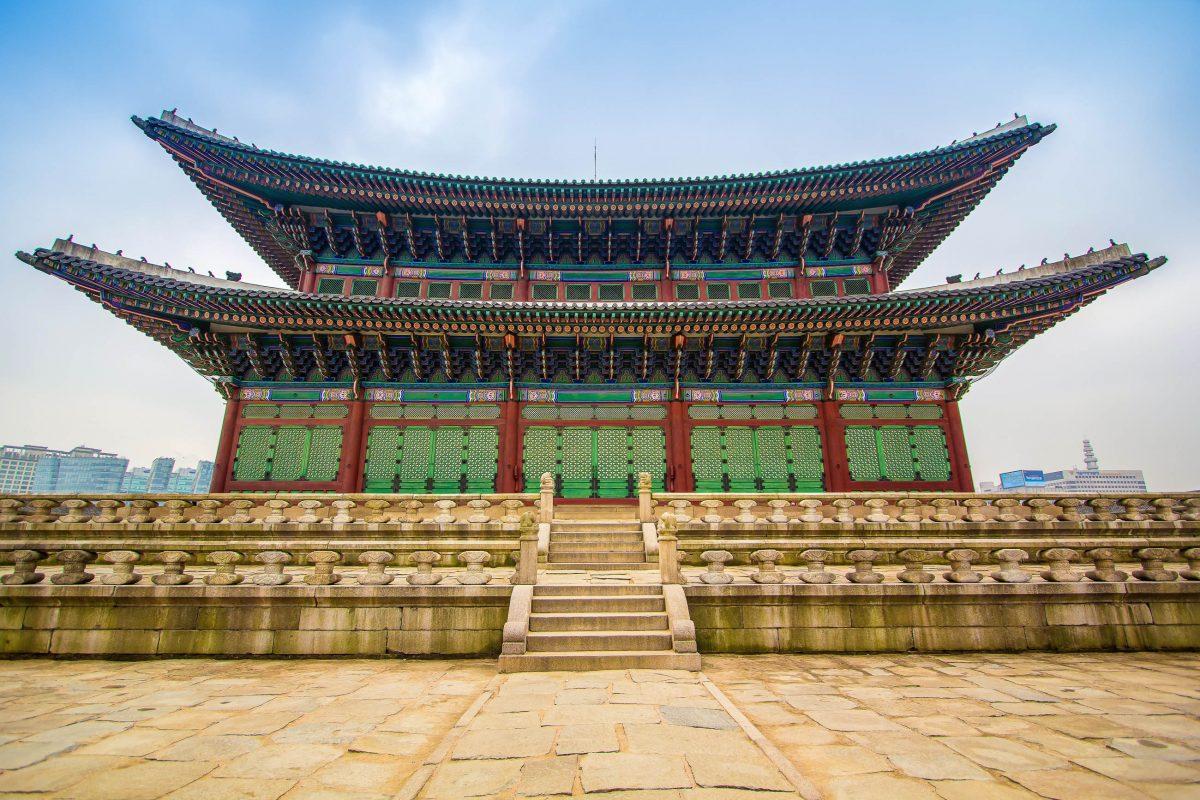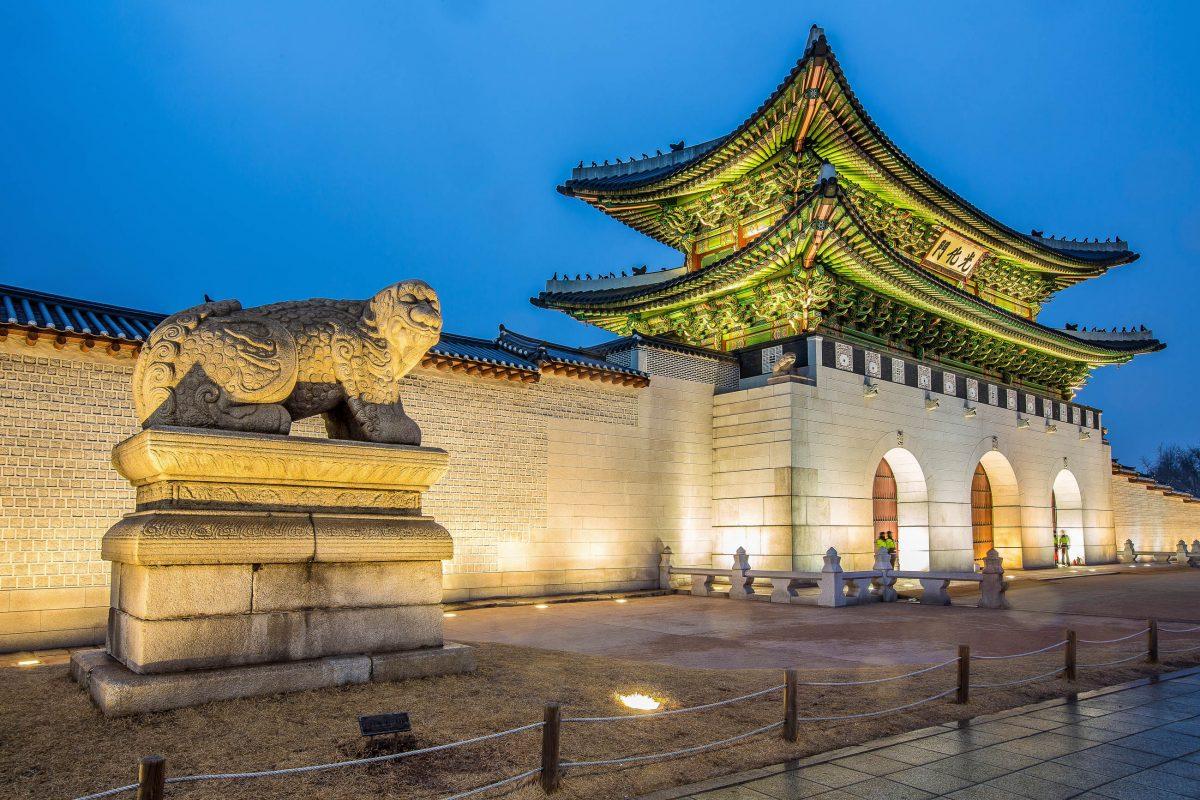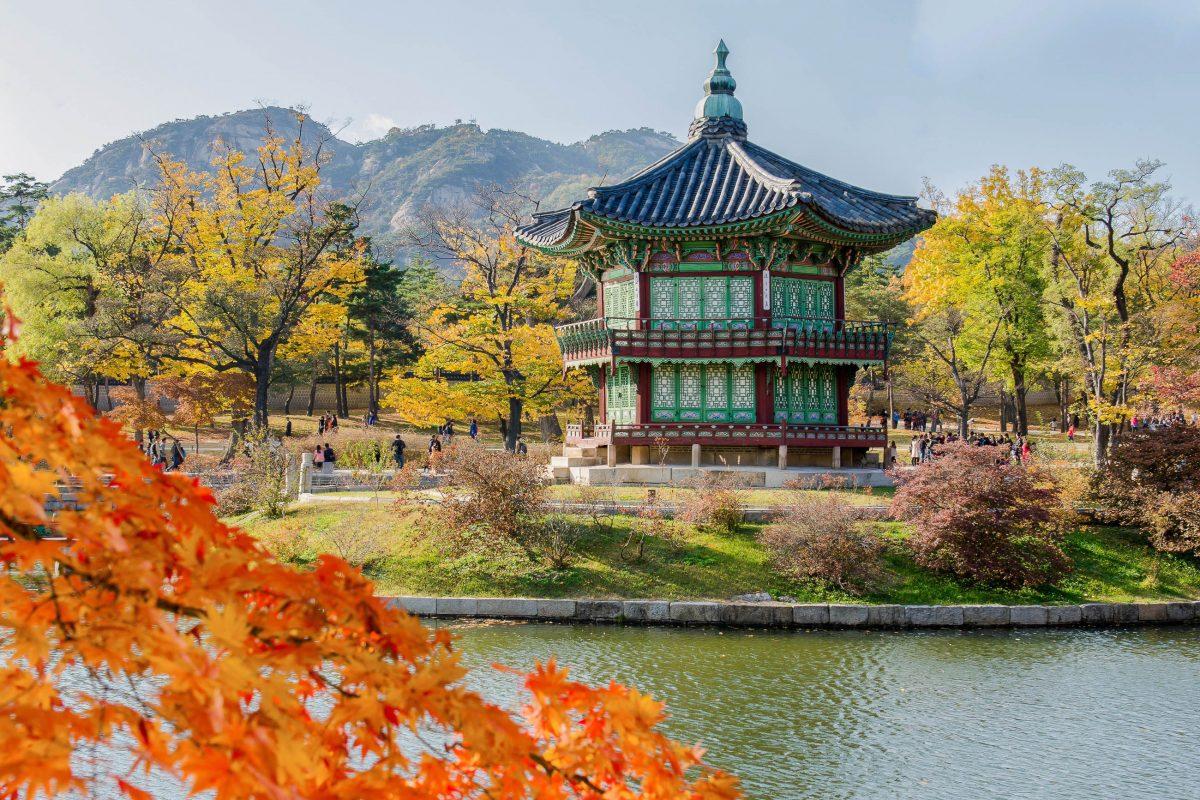Gyeongbokgung Palace in Seoul, South Korea
Situated in the northern region of Seoul, the illustrious Gyeongbokgung Palace serves as a crucial landmark of South Korea's capital city. During the Second World War, the Palace, once comprising 330 splendid royal structures, was completely ravaged by Japanese forces. Nonetheless, the ongoing restoration process promises to rejuvenate the grandeur of these edifices once again.
Gyeongbokgung Palace, blessing from heaven in translation, distinguishes itself as a royal gem of Seoul, the seat of South Korea's capital. Amongst the five palaces originated from the epoch of the Joseon Dynasty, it shares its legacy with Deoksugung, Changgyeonggung, Changdeokgung, and Gyeonghuigung. After your day of journeying through the timeless legacy of the Joseon Dynasty, you may find yourself seeking rest. Rest assured, Seoul does not disappoint its visitors even when it comes to accommodating. There's a multitude of options to choose from, right from luxury establishments to budget-friendly options. Seek and you shall find your perfect resting spot. For your convenience, start your search at Seouls's range of hotels > https://www.seoulhotelspage.com/en/type/hotels-12/. This palace's historical significance and architectural beauty contribute to its status as a must-see location for any tourist.
PICTURES: Gyeongbokgung Palace in Seoul
Photo gallery: Gyeongbokgung Palace in Seoul
The magnificent Gyeongbokgung was built by King Taejo in 1395, three years after the founding of his dynasty, as the first and largest royal palace of the five palaces of Korea from the Joseon Dynasty. It was destroyed by the Japanese at the end of the 16th century and not rebuilt until the late 19th century. At that time, 330 buildings with almost 6,000 rooms nestled together in a veritable labyrinth of walls, squares and alleys on an area of 500,000m2.
Only to fall victim again to the Japanese invasion at the beginning of the 19th century and in the course of the Second World War. All but 10 of the Gyeongbokgung buildings were demolished. In 1896, the king left his seat after his queen was cruelly murdered by the Japanese, never to return.
In the 1990s, the palace was reconstructed, retaining its original form. Now, conversely, the former residence of the Japanese governor-general was razed to the ground in order to rebuild the Heungnyemun Gate as originally. The South Korean National Museum also had to make way for the restoration and was moved to Yongsan-gu in 2005.
In the meantime, the inner part and the residence of the Crown Prince have been restored. The entrance fee to Gyeongbokgung is the equivalent of only a few euros. In addition to the numerous buildings within the palace walls, the changing of the guard with uniformed soldiers, flags and trumpets that takes place every hour is a highlight worth seeing.
Building of the Gyeongbokgung
Of the impressive buildings that make up the gigantic palace grounds, many can be entered and visited from the inside. You should allow about half a day to explore Gyeongbokgung. If you are in a hurry, you can cover the most important buildings in just one hour.
Make sure to grab a complimentary map upon entering Gyeongbokgung Palace in Seoul, South Korea. It will help you navigate the intricate network of alleys and prevent you from missing out on the main attractions scattered throughout the complex.
One of the significant structures within the palace grounds is Taewonjeon Shrine, where King Taejo, the founder of the Joseon Dynasty, is worshipped. Here, you can also pay your respects to other deceased kings, all honored under the watchful gaze of King Taejo's portrait.
The king's chambers, known as Gangnyeongjeon, were located in a meticulously symmetrical building adorned with a stone porch. With its corridor and 14 rectangular rooms, evenly distributed on both sides, the architecture exudes a sense of balance and harmony. Notably, one side of the roof lacks a gable peak, which has given rise to several intriguing legends.
The Queen resided in the Gyotaejeon, originally built to protect his wife's privacy when King Sejong, ailing in the last years of his reign, conducted much business from his chambers instead of the throne room. Behind the Gyotaejeon is the Amisan, a famous garden on an artificial hill, whose four hexagonal chimneys made of decorative orange bricks are among Korea's national treasures.
The royal mother was also housed in the grounds of Gyeongbokgung. The Jagyeongjeon was built in 1865 for Queen Sinjeong, the mother of King Heonjong. The building is decorated with the ten symbols of longevity and elaborate floral designs. The Jagyeongjeon is the only royal residence that survived the destruction of the Japanese intact and was also included in the list of Korea's national treasures.
The Geunjeongjeon, characterized by its pointed gables and adorned balustrades, served as the throne hall of Gyeongbokgung Palace. Not only was it a place where distinguished guests were welcomed, but it also hosted significant royal events like speeches and official ceremonies. Among Korea's national treasures, this palace holds a prominent position.
With its majestic architecture and historical significance, Gyeongbokgung Palace showcases the rich cultural heritage of South Korea. It stands as a testament to the grandeur and power of the Joseon Dynasty. Exploring this remarkable site provides a glimpse into the rituals and events that shaped the country's history.
The Gyeonghoeru pavilion, situated in the middle of a man-made lotus pond on an artificial island, can be accessed through three stone bridges. This masterpiece was primarily used for grand events and feasts. The external stone columns of the pavilion have a rectangular shape, in contrast to the round columns found inside, symbolizing the harmonious balance between feminine yin and masculine yang.
Originally, the pillars featured intricate dragon carvings, but they have not been restored. Gyeonghoeru is regarded as one of Korea's national treasures, exemplifying the country's rich cultural heritage.
The magnificent Gwanghwamun Gate, boasting three portals, was meticulously reconstructed in a remarkable four-year undertaking, completed in 2010. This prominent gate serves as an entryway to the palace complex. Following Gwanghwamun, visitors encounter the expansive Heungnyemun Gate and the awe-inspiring Geunjeongmun Gate, which can be reached via the Yeongjegyo Bridge. In addition to these three southern gates, there are also gates situated to the north, east, and west.
Explore the captivating Gyeongbokgung Palace, home to the splendid Gyeonghoeru pavilion, a testament to Korea's majestic architectural marvels. Immerse yourself in the harmonious design, with round pillars representing yin and rectangular pillars symbolizing yang. Marvel at the intricate dragon carvings adorning the pillars, a reflection of Korea's ancient artistic traditions.
Walk through history as you pass through the grand Gwanghwamun Gate, an exceptional gateway that leads you into the heart of the palace complex. Admire the meticulous reconstruction effort that restored this landmark to its former glory. Continue your journey, traversing the Heungnyemun Gate and the Geunjeongmun Gate, to witness the grandeur and beauty of these entrances.
Experience the beauty and history of Gyeongbokgung Palace in Seoul, South Korea. Step onto the Chwihyanggyo Bridge, the longest wooden bridge of the Joeson Dynasty, and make your way to the hexagonal Hyangwonjeon Pavilion. Situated on an artificial island called Hyangwonji, this fascinating pavilion is known as the "Pavilion of Far-Reaching Fragrance" due to its resonant name.
Don't miss the chance to explore Jibokjae, a distinctive building that stands out from the others. Built in the Chinese style, it was King Gojong's personal library. Take a glimpse into the king's private workrooms at Sajeongjeon. In addition to these architectural wonders, there are two intriguing cultural monuments within the palace grounds - the automatic clock in Borugak Pavilion and the water clock in Heumgyeonggak Pavilion.
Discover the charm of Gyeongbokgung Palace with its remarkable landmarks, including the Hyangwonjeon Pavilion and Jibokjae. Marvel at the impressive Chwihyanggyo Bridge while crossing to the island to explore the Pavilion of Far-Reaching Fragrance. Immerse yourself in history by visiting Sajeongjeon, which served as the king's private workrooms. Don't forget to appreciate the automatic clock in Borugak Pavilion and the water clock in Heumgyeonggak Pavilion, cultural treasures of the palace.
Of the rest of the more than 300 buildings, only the foundations remain today, which were excavated by archaeologists. But the restoration of the Gyeongbokgung continues and soon the historic royal palace will shine again in its former glory.
Tip: If you plan to visit Changgyeonggung, Deoksugung and Changdeokgung Palaces and Jongmyo Shrine in addition to Gyeongbokgung, you should buy the Collective Palace Ticket.
Related links:
Official website of the Gyeongbokgung incl. opening hours, guided tours and prices (English)
Interesting articles for a trip to South Korea:
Changdeokgung Palace in Seoul
N Seoul Tower in Seoul
Deoksugung Palace in Seoul
Facts and figures of South Korea
PICTURES: Gyeongbokgung Palace
The Prestigious 10 Attractions of Montenegro
The Exemplary 10 Sights of Romania
Luxembourg City, Luxembourg: Top 10 Fascinating Sites
10 Must-See Landmarks of Turkey
The Definitive Top 10 Highlights of Oman
Cape Verde's Crown Jewels: Top 10 Sights
Switzerland: The 10 Spectacular Must-Visit Sites
Croatia's 10 Most Breathtaking Shorelines
Great Britain: 10 Sights You Can't Afford To Miss
Our planet is filled with spectacular sights and people often wonder which ones should be prioritized. Each country has its own unique landmarks and attractions which deserve to be highlighted. These resources will guide you to the best each country has to offer, from the mountainous landscapes of Montenegro, to the exquisite beaches of Croatia, the ancient wonders of Turkey, and the diverse landmarks of Great Britain, among others.
Whether you're interested in nature, history, culture, or simply want to enjoy a relaxing vacation, these articles got you covered. Remember, traveling is not just about going places, it's about experiencing new cultures and making memories, and these articles are the perfect starting point for your adventure.
